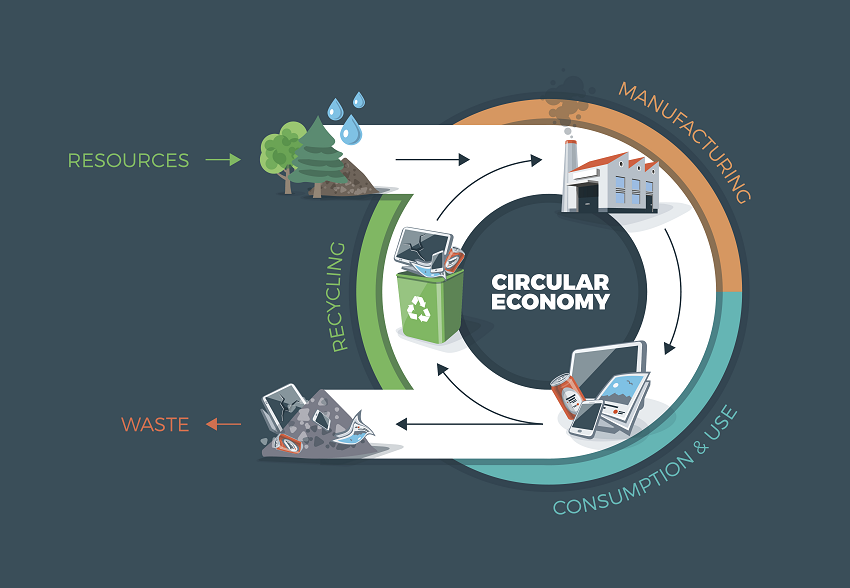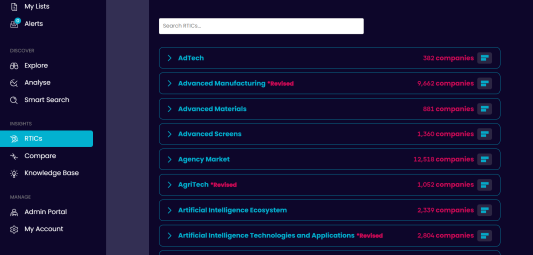The idea of a Circular Economy has become increasingly relevant during the last few years. From policy-makers to key stakeholders of the private sector, talks about circular economies are changing the way we organise resources.
However, many are still unsure of what “Circular Economy” really means. In this blog, we want to contribute to the definition of the Circular Economy using our Real-Time Industrial Classifications (RTICs).
The Circular Economy, what is it?
The Circular Economy refers to a mode of production and consumption that aims to maximise the use of local resources and the repurposing of waste. It implies a change in socioeconomic behaviour that brings people to prioritise local products and to understand waste as an input. This is why is called “circular”: leftover resources are always reintroduced into the economy after being consumed.

Circular economies are more sustainable than more traditional, or linear, modes of production. On one hand, if people start consuming more local and seasonal products, the contamination related to goods transport will decrease. On the other hand, repurposing waste results in fewer landfills and an overall more sustainable management of natural resources. Hence, circular economies are ways of consuming and producing that think local and aim towards zero-waste outcomes.
The Circular Economy sector today
The fact that circular economies are not tightly defined makes it difficult to capture relevant industrial data. For these cases, RTICs can be a useful tool. RTICs are datasets developed through a machine learning process that analyses the website text of a set of companies, and finds others that use similar language. This way, we can address sectors that are not directly addressed in traditional frameworks for industrial classification.
For this piece of work, we have selected a series of industry verticals across relevant RTICs -like Net Zero, Cleantech or Agritech – that define key economic activities of circular economies, like vertical farming, waste management or adapted goods. This way, we can easily create datasets for sectors with existing RTICs. This means that, even if we have not mapped a particular sector, you can build your own with the available resources.
From our data we identified 4,117 companies working in the Circular Economy sector that made over £28bn in revenue and employ almost 112k people in the UK.

Companies that make up the Circular Economy have received considerable funding. The data suggests that the private sector invested almost €488M in the companies in the dataset, while they received over £94M in grants. Companies like Vertical Future, which makes crop production possible in tight urban areas, or Nova Pangea, which specialises in repurposing plant residues, are some of the recipients of funding. This showcases that more sustainable food-producing systems and upholding the value of organic waste are critical for the industry and other key stakeholders.
Where are the companies that make up the Circular Economy?
The map below shows how many Circular Economy companies are located in each local authority. The map suggests that the Circular Economy is more prevalent in more rural Local Authorities, with Cornwall at the lead.
The Data Explorer also provides location quotient values for business counts, which reinforce the idea of a rural Circular Economy by showing that principal urban Local Authorities -i.e., the LAs that build up London- are under-specialised in these activities.
Thanks to the website text data and enrichment tools, we can also identify dominant narratives and practices per region. The platform can identify overrepresented keywords or key phrases in comparison to the average UK company. With this information, we can estimate the principal activities in a region.
| NUTS1 Region | Activity 1 | Activity 2 | Activity 3 | Activity 4 | Activity 5 |
|---|---|---|---|---|---|
| East | Agritech | Energy from Waste | Environmental Consultancy | Hazardous Waste | Waste Treatment |
| East Midlands | Energy from Waste | Hazardous Waste | Environmental Consultancy | Waste Treatment | Circular Economy |
| London | Clean Tech | Energy Storage | Gasification | Energy Generation | Circular Economy |
| North East | Hazardous Waste | Energy Storage | Circular Economy | Waste Management | Low Carbon |
| Northern Ireland | Waste Water | Waste Treatment | Waste Management | Renewable Energy | Solar |
| North West | Energy from Waste | Hazardous Waste | Environmental Consultancy | Waste Treatment | Circular Economy |
| Scotland | Energy from waste | Carbon Capture | Circular Economy | Waste Treatment | Energy Storage |
| South East | Energy from waste | Carbon Capture | Gasification | Non-hazardous Waste | Energy Generation |
| South West | Energy from waste | Carbon Capture | Environmental Consultancy | Energy Generation | Hazardous Waste |
| Wales | Environmental Consultancy | Energy from Waste | Hazardous Waste | Circular Economy | Waste Management |
| West Midlands | Non-hazardous Waste | Energy from Waste | Hazardous Waste | Environmental Consultancy | Circular Economy |
| Yorkshire | Beccs | Demand Side Response | Clean tech | Carbon Capture and Storage | Chp |
Wrapping up the Circular Economy
There is a need for clarity around the Circular Economy. It is important to understand which are the principal sectors that can make it possible, who are the key players and where are they based. A big data-based approach to the task can help fill the gaps by providing a complementary view of what the Circular Economy is.
If you want to know more about the Circular Economy, RTICs or the method behind the product, get in touch.


